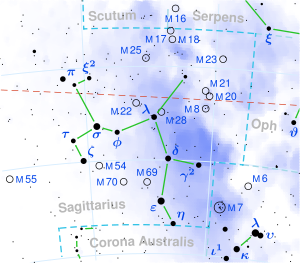| Observation data Epoch J2000 Equinox J2000 | |
|---|---|
| Constellation | Sagittarius |
| Right ascension | 18h 03m 52.44501s[1] |
| Declination | −24° 21′ 38.6323″[1] |
| Apparent magnitude (V) | 5.97[2] |
| Characteristics | |
| Spectral type | O4V((f))z[3] (O3.5V((f+)) + O5–5.5V((f))[4]) |
| U−B color index | −0.89[2] |
| B−V color index | 0.00[2] |
| Astrometry | |
| Radial velocity (Rv) | 10.70[5] km/s |
| Proper motion (μ) | RA: +0.539[1] mas/yr Dec.: −2.019[1] mas/yr |
| Parallax (π) | 0.8001 ± 0.0728 mas[1] |
| Distance | 4,100 ± 400 ly (1,200 ± 100 pc) |
| Absolute magnitude (MV) | −6.20[4] |
| Orbit[6] | |
| Period (P) | 3,261±69 d |
| Semi-major axis (a) | 4,100 R☉[7] |
| Eccentricity (e) | 0.648±0.009 |
| Inclination (i) | 86.5±0.5° |
| Semi-amplitude (K1) (primary) | 36+4 −1 km/s |
| Semi-amplitude (K2) (secondary) | 49±3 km/s |
| Details[6] | |
| 9 Sgr A | |
| Mass | 32.1±16.0 M☉ |
| Radius | 10.8±1.0 R☉ |
| Luminosity | 479,000 L☉ |
| Surface gravity (log g) | 3.87±0.20 cgs |
| Temperature | 46,000±1,000 K |
| Rotational velocity (v sin i) | 102+8 −12 km/s |
| 9 Sgr B | |
| Mass | 18.9±10.1 M☉ |
| Radius | 8.9±1.2 R☉ |
| Luminosity | 224,000 L☉ |
| Surface gravity (log g) | 3.87±0.20 cgs |
| Temperature | 42,000±1,000 K |
| Rotational velocity (v sin i) | 67+6 −13 km/s |
| Age | ~1 Myr |
| Other designations | |
| Database references | |
| SIMBAD | data |
9 Sagittarii (9 Sgr) is a massive binary star in the constellation Sagittarius. It has an apparent magnitude of 5.97. Both components are highly luminous O-type main-sequence stars.
- ^ a b c d e Vallenari, A.; et al. (Gaia collaboration) (2023). "Gaia Data Release 3. Summary of the content and survey properties". Astronomy and Astrophysics. 674: A1. arXiv:2208.00211. Bibcode:2023A&A...674A...1G. doi:10.1051/0004-6361/202243940. S2CID 244398875. Gaia DR3 record for this source at VizieR.
- ^ a b c Ducati, J. R. (2002). "VizieR Online Data Catalog: Catalogue of Stellar Photometry in Johnson's 11-color system". CDS/ADC Collection of Electronic Catalogues. 2237. Bibcode:2002yCat.2237....0D.
- ^ Sota, A.; Maíz Apellániz, J.; Morrell, N. I.; Barbá, R. H.; Walborn, N. R.; Gamen, R. C.; Arias, J. I.; Alfaro, E. J. (2014). "The Galactic O-Star Spectroscopic Survey (GOSSS). II. Bright Southern Stars". The Astrophysical Journal Supplement. 211 (1): 10. arXiv:1312.6222. Bibcode:2014ApJS..211...10S. doi:10.1088/0067-0049/211/1/10. S2CID 118847528.
- ^ a b Rauw, G.; Sana, H.; Spano, M.; Gosset, E.; Mahy, L.; De Becker, M.; Eenens, P. (2012). "9 Sagittarii: Uncovering an O-type spectroscopic binary with an 8.6 year period". Astronomy & Astrophysics. 542: A95. arXiv:1205.3314. Bibcode:2012A&A...542A..95R. doi:10.1051/0004-6361/201219254. S2CID 19967446.
- ^ Gontcharov, G. A. (2006). "Pulkovo Compilation of Radial Velocities for 35 495 Hipparcos stars in a common system". Astronomy Letters. 32 (11): 759–771. arXiv:1606.08053. Bibcode:2006AstL...32..759G. doi:10.1134/S1063773706110065. S2CID 119231169.
- ^ a b Cite error: The named reference
fabry2021was invoked but never defined (see the help page). - ^ Krtička, J.; Kubát, J.; Krtičková, I. (2015). "X-ray irradiation of the winds in binaries with massive components". Astronomy & Astrophysics. 579: A111. arXiv:1505.03411. Bibcode:2015A&A...579A.111K. doi:10.1051/0004-6361/201525637. S2CID 119120927.
